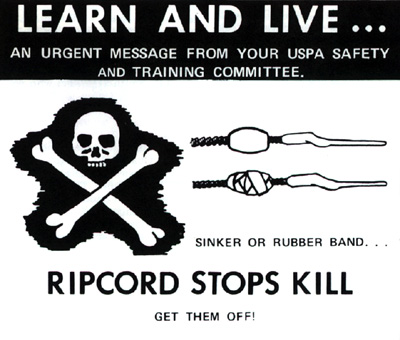Featured Exhibits
Sign up for the Newsletter
Advertise on ParachuteHistory.com
Disclaimer
Privacy Policy
About
Ripcord Stops
Ripcord Stops - they seemed like a good idea at the time. The time was back in the 1960's. Sport parachuting was growing in leaps and bounds.Jumpers used ripcord activated equipment. The main ripcord was on the right hand side main lift web. It could be either in-board or out-board.
At pull time, a jumper would reach in and pull it, then quickly go back into a hard arch.
Wouldn't you know it... sometimes people let go of the ripcord after pulling. It went sailing off into the wild blue yonder, plummeting towards earth, finding a new home amongst the tumbleweeds.
A brilliant jumper decided to put a stop on the ripcord cable. The stop prevented the entire cable from clearing the housing - even if you dropped the ripcord handle.
The stop was a lead fish sinker placed, usually, between the last two pins. Back then main ripcords had 3 or 4 pins. Once the stop hit the edge of the ripcord housing, it could not go further.

The stop could also be a rubberband. The rubberband, cut at one place and tied securely with two square knots. The rubberband stop had a slight advantage over the lead sinker stop in that it would not be blocked or stopped by the pin protector flap. The rubberband stop could also be more easily removed than a lead sinker stop.

On an actual jump, jumpers either just let go of the ripcord handle or stowed the pulled main ripcord back in the pocket.
Many would-be lost ripcords were saved by this ingenious invention.
But that's not all...
Many would-be alive jumpers were killed because of this ingenious invention too. In case of an emergency, it is easier to throw away the main ripcord than to stow it in the pocket. If you had a ripcord stop then there is a great possibility that it could hang up on the cutaway main.Other jumpers experienced complicated situations because of this ingenious invention. They are alive to tell their tale:
March 1968: Larry Lanham, C-2861, had a ripcord with a cable stop on it. After he pulled, he let go of the ripcord when he felt the tug of the main opening. On one particular jump, he looked up at a malfunctioning main, just after he let go of the ripcord. He quickly released his one-shot riser releases.
He looked up again and saw his main still attached to him and wondered why the Steven's lanyard did not open the reserve.
He soon realized that the main ripcord handle had snagged the main risers. Since the ripcord stop held the ripcord to his rig, he was dragging a cutaway main behind him.
He managed to relief pressure on the ripcord cable and free himself. He then activated the reserve at 600 ft.
(Geronimo says: 'Never depend on your Steven's lanyard, the predecessor to the modern day RSL, to activate your reserve. You should always pull the reserve handle after a cutaway.')
Nov. 1969: George Krueger had a total malfunction because of a ripcord stop and the pin protector flap. The pin protector flap had 'pull the dot' snaps and held the ripcord cable with a stop attached just above the bottom pin firmly in place.
The 'solution' to this problem was to install small wire spring type snaps and extend the flap protector.
1972: Fay Huntley had cutaway her main after landing in high winds. The ripcord, held to the harness with a ripcord stop, entangled with a cutaway main, allowing her to be dragged. Her reccomendation was "Put your ripcord in the pocket immediately after opening!'
1972: James Whittaker mentioned that the best way to avoid being dragged by a ripcord held by a ripcord stop is to remove the ripcord stop. He mentioned that ripcord stops have caused totals to horseshoe streamers.
1974: Cable stops were banned at the 1974 US Nationals.
1974: Queen's Skydiving Club in Kingston Ontario reported that since ripcord stops were removed from main ripcords, students loose the ripcord more often.
1975: Robert Bastien switched rigs with a friend for a jump. His opening was taking a bit long, so he threw the ripcord away so he could cutaway. Just as he did this his main opened. Blammmm! The ripcord he threw away swung back around and hit him in the teeth - knocking one out. The ripcord had a ripcord stop. The ripcord stop was removed before the next jump.
Darwin Wins!
Ripcord stops were eventually banned everywhere. They caused many fatalities and serious complications of towed cutaway mains. They were a bad idea that unfortunately made it into the parachuting world.

Geronimo says: 'You can do everything right and still die in parachuting.'
[Products] | [Services]
[Join Our Mailing List] | [Advertise on ParachuteHistory.com]
[ ]
[Disclaimer] | [Privacy Policy] | [About]